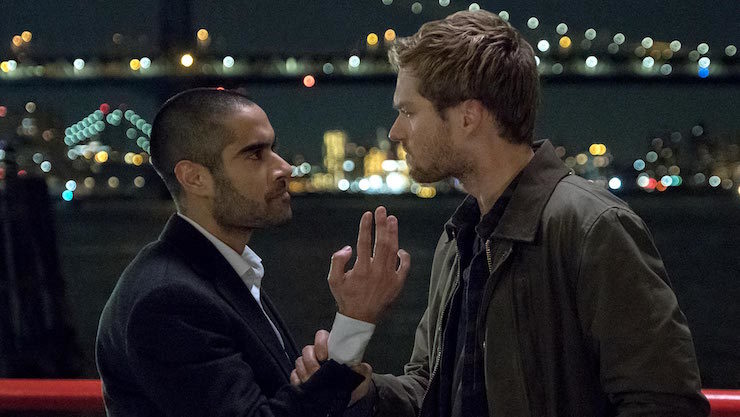Two of the major supporting characters for Iron Fist from shortly after his debut in Marvel Premiere were Misty Knight—an ex-police detective with a bionic arm—and Colleen Wing—a sword-wielding martial artist. The pair of them teamed up as private investigators as Nightwing Restorations, and also have done the superhero thing as the Daughters of the Dragon.
In the Marvel Cinematic Universe (Netflix edition), Wing was introduced in Iron Fist, while Knight was introduced in Luke Cage, and where Danny Rand dated Knight in the comics, he falls into bed with Wing in his series, and they have remained a couple. Wing and Knight finally got thrown together in The Defenders (where Knight lost her arm) and they reunited for two glorious scenes in Luke Cage season two (where Knight got her bionic arm).
Then we have the middle episodes of Iron Fist season two and can we for the love of all that is good and noble in this world have a Daughters of the Dragon series PLEASE?????
SPOILERS FOR IRON FIST SEASON TWO, AS WELL AS THE OTHER MCU NETFLIX SHOWS.
I might be slightly obsessive on the subject, but M. Raven Metzner and his band of writers made it clear that this is a thing by taking Rand out of action for several episodes, recovering from injuries and wounds and a broken leg. For the better part of three episodes, and bits of three more, we get this superb pairing that has been a solid partnership in the comics since the 1970s.
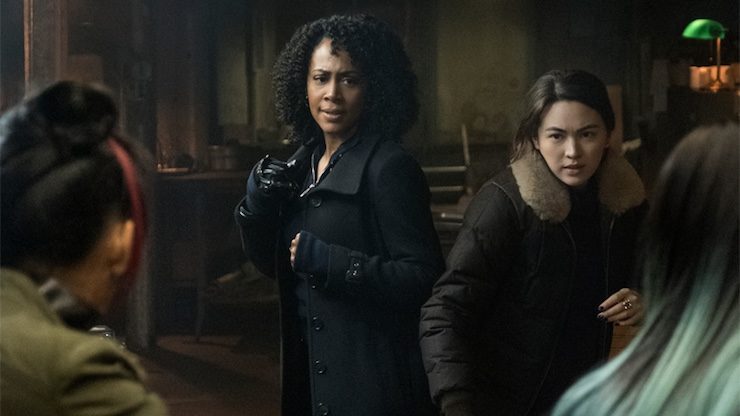
It helps that Simone Missick and Jessica Henwick are simply glorious together. Finn Jones’s slightly whiny affect is far less annoying than it was in his previous season, and I was much more convinced by Rand and Wing as a couple this season than I was last time, but where Henwick and Jones are perfectly fine as a pairing, Henwick and Missick are simply superb. Every time the camera’s on them, they shine, whether they’re talking about what to do next with their lives, Knight’s bitching about Wing’s inability to get her the habañero chips she asked for, or kicking the asses of the Crane sisters at the tattoo parlor.
Buy the Book
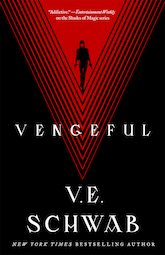

Vengeful
And these bits are by far the most compelling parts of Iron Fist season two. The season overall is far stronger than season one, but that’s a pretty low bar to clear. At the very least, Metzner understands that he’s adapting a superhero comic about a martial artist. Scott Buck, for reasons known only to the voices in his head, decided that Rand Enterprises was an important part of the Iron Fist story (it never ever ever has been), thus giving us a first season that was more Suits than Into the Badlands. Season two has precisely one scene in Rand Enterprises itself, and it’s Ward Meacham leaving the building. That’s it. And it’s as it should be.
The season’s main theme is recovery from trauma. Everyone is dealing with the aftermath of some kind of personal disaster, and how they deal with it shapes the entire season. Rand no longer has his home, as K’un L’un is gone, and the Iron Fist’s purpose—to fight the Hand—is also not a factor anymore, and he spends most of the season trying to figure out who and what he is. Wing has stopped teaching, as that’s a remnant of her life as a disciple of the Hand, and she needs to move past that—but she’s not sure how. She finds her work in the community center to be satisfying, but she also never has an answer to Knight’s question about where she sees herself in five years. It’s also telling that the only time Wing seems alive and happy is when she’s in a fight.
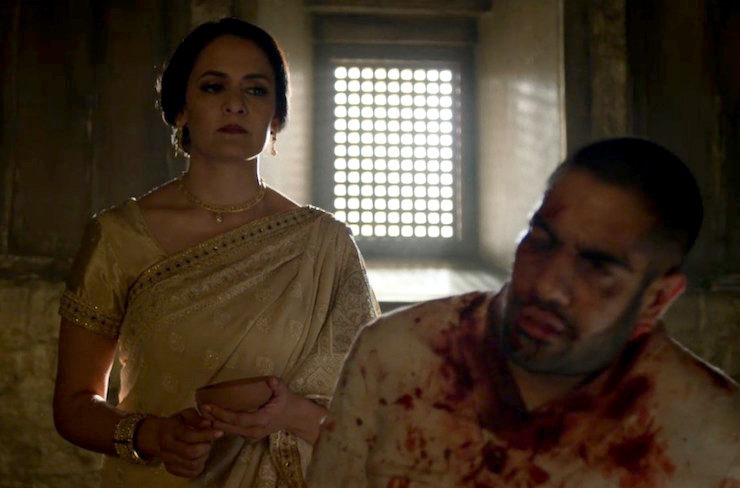
Davos has also lost K’un L’un, but we find out even more about him that explains his behavior: he was raised by, in essence, a pageant Mom. Priya is revealed through Davos’s flashbacks to be a brutal taskmaster, obsessed with making sure Davos becomes the Iron Fist. The earlier flashback to Davos and Rand’s final fight before facing Shao Lao becomes more complex, because Priya’s disgust in that scene wasn’t because she was about to watch her son die but because she didn’t want to watch her son fail. I really wish we’d seen more of Lei Kung—and not just because Hoon Lee is awesome. The dynamic among Kung, Rand, and Davos was an integral component of the comics stories, and adding Priya to the mix is fascinating. But I feel like there could be more.
Sadly, while the backstory is compelling, the front-story falls short. Sacha Dhawan was a high point of season one as Rand’s angry brother with complex feelings about him, but he utterly fails as a straight-up villain. He’s become completely deranged with the loss of K’un L’un, turning himself into a murderer with a messiah complex. This has potential, but it’s all unfulfilled, and it’s sadly on the back of a disappointingly one-dimensional performance by Dhawan, whose controlled rage worked so well last time, but which just makes him stiff and boring as a villain this time. (It doesn’t help that the bar has been set so high by Vincent D’Onofrio’s Kingpin, Mahershala Ali’s Cottonmouth, Wai Ching Ho’s Madame Gao, David Tennant’s Kilgrave, Alfre Woodard’s Dillard, and Sigourney Weaver’s Alexandra.)
Ward’s time in Narcotics Anonymous is one of the best templates for the season, because everyone’s doing the twelve steps to some extent or other. Ward himself keeps trying not to be an asshole, but he has no frame of reference for anything else, and it doesn’t help that every attempt to make up with Joy is batted aside by his sister. Joy herself has plenty of trauma to overcome, as she’s still livid at Rand and Ward for hiding that her father was alive, plus she got shot. That’s not something she can easily forgive.
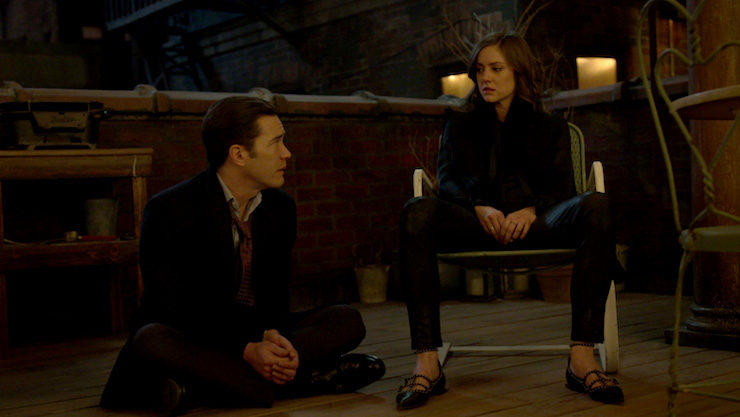
But there’s one great moment between the Meacham siblings on the patio outside Rand and Wing’s apartment, and it’s so beautifully played by Jessica Stroup. It’s when Ward reveals that all the times he was hurt, claiming it was skiing or an accident at home or whatever, it was actually Harold Meacham beating up his son. The change in Joy’s expression is subtle but obvious: she goes from the pure hatred that’s been on her face every single time she’s been in Ward’s presence, to a weird kind of confusion. She doesn’t soften, but this is new information. For the first time she understands that she wasn’t the only victim of Harold’s mendacity. She stops viewing Ward as her enemy at that point, though she never brings herself all the way around to being his loving sister again. But she finally understands that there was a lot more to what happened than Rand and Ward being mean to her.
The plotline bounces the iron fist around like a hot potato, as Davos steals it from Rand—an entertaining adaptation of Marvel Team-Up #63-64—and then our heroes work to steal it back. But Rand doesn’t want it. Because for the first time here we get the notion that the iron fist is, itself, addictive, or at least a distraction. Davos is able to channel his chi into either of his fists, something Rand could never do, and Rand isn’t sure he’s ready to be Iron Fist again. He instead suggests Wing take it.
This is a lovely maneuver, and just makes it more likely that we’ll get our Daughters of the Dragon series (especially since Knight is one of the ones pushing Wing to accept the iron fist, knowing that she’ll wield it right). Or maybe Iron Fist season three can just be about Wing and her cop buddy, since she has the iron fist now…
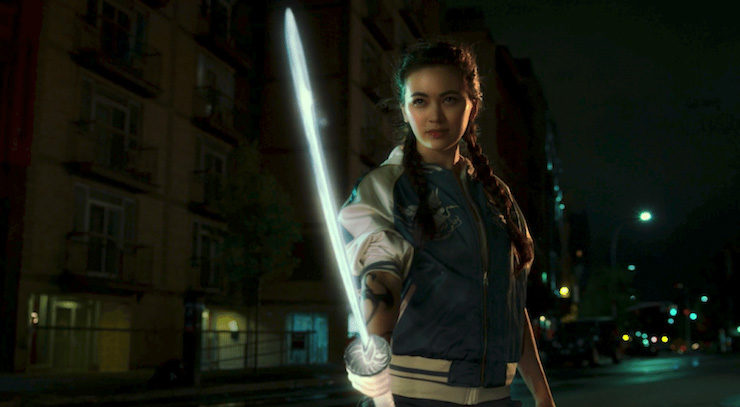
Either way, the seductive power of the fist is an interesting theme, though it’s not as well explored as it might be. It does keep to the recovering-from-addiction theme, as both Rand and Davos see themselves becoming more unstable upon achieving the iron fist. Rand at least recognizes it and refuses it, instead going off to Asia to find out more about the previous Iron Fists, bullying Ward into joining him.
Three other things I want to mention about this season. One is that this series delightfully goes out of its way to pass the Bechdel Test early and often. There are a lot of strong, powerful women in this season, from Joy to Walker to Mrs. Yang (who effortlessly takes over the Hatchet Triads after Davos kills her husband) to Knight and Wing to Priya. And while some of them are defined too often in terms of the men in their lives (Priya and Joy in particular, Wing to a lesser extent), they aren’t all, and aren’t always. It’s done with a minimum of fuss, too. (It’s also fitting. Two of the most influential writers of Iron Fist back in the day were Chris Claremont, who has always written strong female characters, and Jo Duffy.)
Having said that, the most superfluous character this season is Mary Walker. As good as Alice Eve does in translating Typhoid Mary to the Netflix MCU, as fascinating a character as Walker is, and as nice as it is to see a cinematic MCU hit (her trauma happened in Sokovia, the war-torn country that was the centerpiece of Avengers: Age of Ultron), the fact is that you could excise Walker completely from this season and it wouldn’t change anything of consequence. Much as I loved the revelation at the end of the dinner party that Joy and Davos had hired Walker to surveil Rand, ultimately that part of the story never made sense. Of all the people in the world who don’t need to gather intel on Rand, it’s Joy (who grew up with him up to age ten) and Davos (who grew up with him from age ten on up). And she adds nothing to the story, as it feels like she’s meandering over territory that The Punisher season one already covered quite well, thanks. Even at ten episodes instead of thirteen, we find ourselves awash in filler…
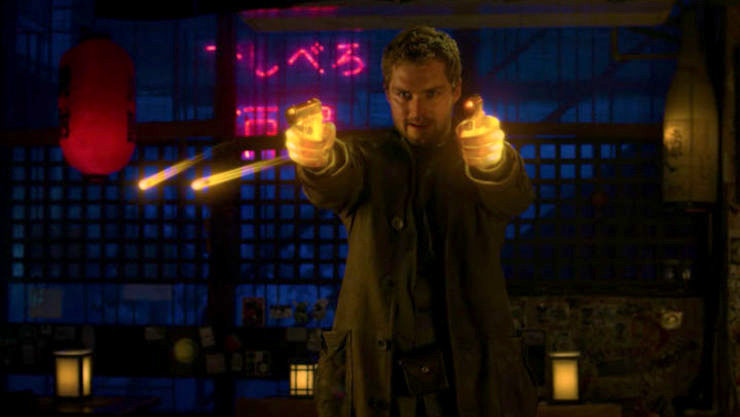
Iron Fist is still the least of the MCU Netflix offerings. Jones remains relentlessly mediocre in the title role. The writing is improved, but still not 100%. I found myself caring much more about the supporting cast than the lead. The final scene—with Wing channeling the fist through her katana and Rand and Ward having adventures through Asia—promises a fascinating third season, at least. I especially like the dual references—one verbal, one visual—to Orson Randall, one of the previous Iron Fists, who channeled his chi through is pistols as we see Rand do in the last scene.
But seriously, let’s just do Daughters of the Dragon and have done with it? Please?
There is a fourth other thing I want to discuss, regarding the fight scenes and the use of martial arts, but that really requires its own article, which we’ll have later this week.
Keith R.A. DeCandido has previously reviewed Iron Fist season one, The Defenders season one, The Punisher season one, and Luke Cage season two for this site. His regular feature, “4-Color to 35-Millimeter: The Great Superhero Movie Rewatch” appears on this site every Friday, and he’s also written about Star Trek, Doctor Who, Wonder Woman, Batman, Stargate, and more. When he’s not dropping pixels here on Tor.com, he’s the author of novels, short fiction, and comics, both in a variety of licensed universes from Alien to Zorro and in worlds of his own creation. His full bibliography can be found here.










